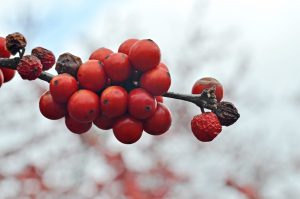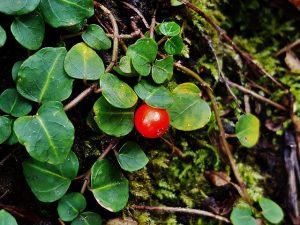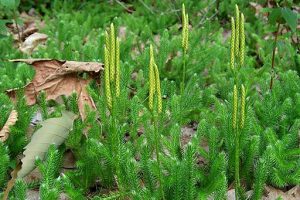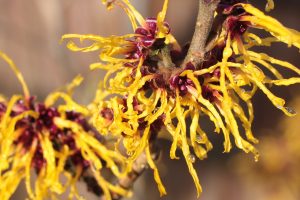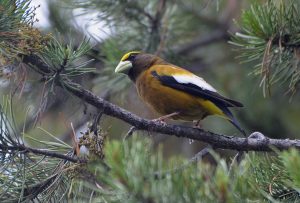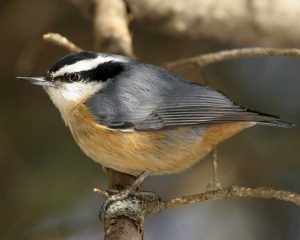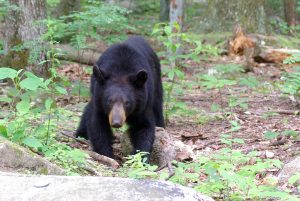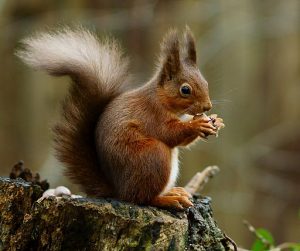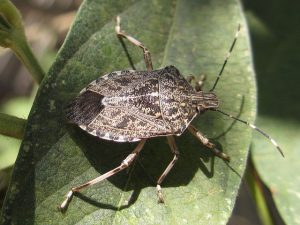Written by Gwyn Loud for the Lincoln Land Conservation Trust. She welcomes your sightings and questions at 781-259-8690 or gwyn_loud@comcast.net.
The past month continued very wet, with many rainy days, interrupted by some welcome sunshine. At least streams are rushing and ponds are full, good for the water table. Temperatures have fluctuated wildly, from highs in the eighties in early October, to hard frost on several nights, then mild days in the sixties in early November. All the rain has kept lawns very green, but it has not helped the fall foliage show, which in general has been muted in color this fall. Many deciduous trees are bare now but the oaks will hang onto their leaves for a long time. This does not seem to be a bumper year for acorns. On a walk in the woods, bright green moss, club moss with its tall erect spore cones, and red berries on the low-growing partridgeberry provide spots of color. Winterberry, a shrub in the holly family often found win damp places, has bright red fruit which is devoured by wildlife, including raccoons and mice and many species of birds. A bulletin from the Extension Service at the University of Maine, quotes Thoreau describing mice eating winterberry: “they run up the twigs at night and gather this shining fruit, take out the small seeds, and eat their kernels at the entrance to their burrows.”
If you come across a shrub with small wispy pale yellow flowers you have found witch hazel, unusual in that it blooms at this season. How are the flowers pollinated when most insects are no longer active? My friend Sigrin Newell, who writes a nature column in upstate New York, explains, “a scientist named Bernd Heinrich discovered that Witch Hazel flowers are pollinated by a few species of night- flying owlet moths. These moths continue to fly in November and December. They are able to shiver to get their body temperature up to the necessary 86 degrees in order to fly. Though these moths mostly feed on the sap of injured trees, they also flock to the nectar of Witch Hazel blossoms, pollinating them in the process.”
The fall bird migration has nearly ended, but there have been recent sightings of lingering Baltimore orioles, gray catbirds, red-winged blackbirds, a killdeer, an eastern meadowlark, and warblers such as palm, magnolia, yellow-rumped, and common yellow-throat. A pine warbler came to our small suet feeder. American pipits have been spotted in plowed fields and various species of sparrows have been busy feeding on weed seeds in fields or along roadsides. Many savannah sparrows have been seen and there have been higher numbers than usual of white-crowned sparrows. Single sightings of clay-colored and vesper sparrows came from Drumlin Farm. Most sparrows will continue their migration farther south but the recently-arrived white-throated sparrows will remain here for the winter and will relish bird seed scattered on the ground. Dark-eyed juncos have also arrived to over-winter here. Other avian reports of note include a yellow-bellied sapsucker, a blue grosbeak in the Food Project Fields, several common ravens, and ruby-crowned kinglets. Three pileated woodpeckers were spotted flying over St. Joseph’s Church just before Sunday mass. Flocks of cedar waxwings and robins have been feeding on fruits such as crab apples and Eastern bluebirds have been seen in small flocks, sometimes investigating bird boxes as if thinking ahead to spring real estate. Some bluebirds always overwinter here; as well as finding wild food, they happily eat dried mealworms and will come to suet feeders. It is predicted that in New England we can expect to see various “irruptive species” this winter due to poor food supplies farther north. Already Lincoln observers have had purple finches and red-breasted nuthatches at feeders, and a particularly exciting report came from Drumlin Farm where ten evening grosbeaks were seen. It has been decades since we have had any significant numbers of these big bold black and gold birds.
There were several sightings of black bear in north Lincoln in late October and a night-time camera photographed a cub. On a walk in Ricci Fields we found probable bear scat and at a house near Bedford Rd. a six-foot pole on which a bird feeder was hanging was bent in half, mostly likely by a bear. Regarding a much smaller mammal, a resident of Old Sudbury Road writes, “The entertainment continues with the tiny red squirrel, living on one side of the yard, trying to protect its black walnut collection from the grey squirrel living on the other side of the yard. The careful approach of the grey squirrel, as quiet as he tries to be, provokes the loud chittering of the tiny squirrel and announces the impending skirmish. If the grey squirrel is fast enough, he gets away with a walnut, but the tenacious red squirrel sometimes chases him until he accidentally drops it.”
Most insects have disappeared, gone into a period of dormancy called diapause as eggs, larvae, pupae, or adults in protected places. An adult insect you may find seeking warmth in your house is the stink bug. Although they are harmful to crops, they do no harm inside, except they may make a smell if squashed. Let’s not forget the monarch butterflies who were so beautiful to see here in the summer and on their southward migration in early fall. Observers at the twelve butterfly sanctuaries in the mountains of Mexico were overjoyed to see the first large waves of migrating monarchs arriving on November 7.
Sky watchers who can stay awake should watch for the Leonid meteor showers between midnight and dawn on November 17 and 18.
© Gwyn Loud


